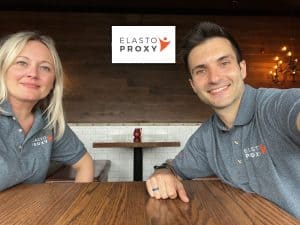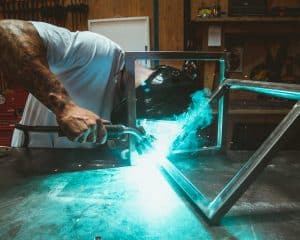Elasto Proxy is a distributor and custom fabricator of industrial rubber products that also offers kitting and assembly packaging services that save you time and money.
- Kitting groups related products together to create a new SKU. This reduces the number of SKUs you need to track and reduces the number of skid spots in your warehouse.
- Assembly packaging arranges kitted parts in order of installation. When you open the box, the part you need to install is right on top. The part you need to install next is right below it, and so on.
Not all kits are arranged in order of assembly, but combining kitting with assembly packaging is a powerful way to speed installation and reduce manufacturing waste.
Watch this video and keep reading this article to learn more about kitting and assembly packaging – and the five benefits you’ll get when you combine then. Then, when you’re ready to save time and money, contact us.
What is kitting?
Kitting groups and packages two or more related products together to create a new stock keeping unit (SKU). SKUs promote efficient operations, but it’s possible to have too much of a good thing. Manufacturers with too many SKUs spend more time finding, sorting, handling, and organizing stock. This add labor costs and requires more storage space. A large number of SKUs can also tie-up cash in inventory and increase a company’s tax liabilities.
Kitting reduces the number of SKUs that you have and reduces these risks and expenses. Related items are packaged together so that they can be ordered, received, warehoused, and used at the same time. For example, a heavy equipment manufacturer can order all of the sealing and insulation that is needed to assemble an off-road vehicle. For each new build, there’s only one SKU to process.
Parts that are kitted are packaged together and shipped in the same box. These parts can be arranged in a particular order or dumped in the box at random. If kitted parts are packaged in order of assembly, an installer will be able to work more efficiently. There’s no need to search for the part to install first or the part to install next. That’s where assembly packaging adds greater value.
What is assembly packaging?
Assembly packaging arranges kitted parts in order of installation. When you open the box, the part you need to install first is on top. The part you need to install next is below the first part, and so on. At the bottom of the box is the part to install last. Because they’re kitted items, all of the parts in the box belong to the same SKU. For kitted items, assembly packaging is even more efficient than standard packaging.
Consider the example of a heavy equipment manufacturer that orders a kit with 25 different parts. An assembler opens standard packaging and looks for the part to install first. If this part has a similar shape or size to another part, the wrong part may get picked. The assembler may then unpack all of the parts on a worktable, search for each part as it’s needed, and then walk back and forth to the line.
Meanwhile, another worker opens assembly packaging that contains the same 25 kitted parts. There’s no confusion about which part to install first since it’s on top. The assembler just follows the work instructions and removes each part from the box when it’s time to install it. There’s no searching for parts and no need to dump them on a table. There’s no walking back and forth from the table to the line either.
In this example, the headliner could be the part that’s on top and that gets installed first. The floor mats get installed last, so they’re on the bottom of the assembly packaging. If this sounds efficient to you, consider going a step further and combining assembly packaging with just-in-time inventory. The kitted items travel in single box right from the receiving area to the line, bypassing the warehouse and all of its associated costs.
What are the five benefits of kitting and assembly packaging?
Now that you understand the basics of kitting and assembly packaging, consider these five benefits. Along the way, remember that while you could kit incoming items yourself, it’s more efficient to buy kits of custom fabricated rubber parts where the components are ready-for-use and packaged in order or installation.
#1 Speed Assembly
Kitted parts are faster to install because everything you need is in the same box. Kitted parts in assembly packaging are even faster to install because the part you need first (or next) is always on top. This eliminates searching – and any potential confusion about what to install where and when.
#2 Reduce Overhead
Kitted parts reduce overhead because there are fewer SKUs to order, receive, store, and pay for. With or without assembly packaging, you can combine kitted parts with just-in-time inventory. In this way, a box of kitted parts can move from your dock to the assembly line and bypass the warehouse.
# 3 Get Volume Discounts
The price of individual items may change over time. Plus, it’s usually more expensive to buy one-off items instead of making regular purchases from a vendor. When you buy kitted items on a schedule, you may be able to get a volume discount since the supplier is regularly selling more parts in fewer shipments.
# 4 Reduce Packaging Waste
Custom fabricated products like rubber parts for heavy equipment don’t require specially-designed packaging if they can fit inside a standard carboard box. These boxes can be recycled, but kitting can reduce the number of incoming boxes that you need to temporarily store and then break-down.
# 5 Reduce Errors
Because kitting means fewer SKUs to handle, it reduces the risk of mistakes during purchasing, receiving, warehousing, picking, and payment. When you combine kitting with assembly, you also reduce the risk of installation error since a worker who follows the job instructions just needs to grab the next part.
How to get started with kitting and assembly packaging
Do you fabricate rubber or plastic parts yourself or buy custom fabricated products with multiple SKUs? Elasto Proxy can help you to increase efficiency, cut costs, minimize risks, and reduce waste. To learn more about kitting and assembly packaging for custom rubber and plastic products like seals, gaskets, and insulation, contact us.










